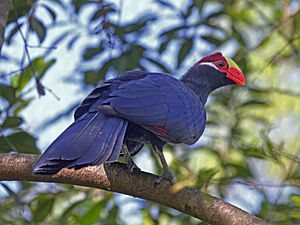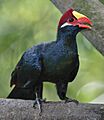Violet turaco facts for kids
Quick facts for kids Violet turaco |
|
|---|---|
 |
|
| At Jacksonville Zoo, Florida | |
| Conservation status | |
| Scientific classification |
The violet turaco, also called the violaceous plantain eater (Tauraco violaceus), is a large and beautiful bird. It belongs to a group of birds called turacos, which are found in Africa.
Contents
About the Violet Turaco
These birds are easy to spot because of their bright colors, but they can be shy. They often hide among the treetops.
What They Look Like
Violet turacos are about 48 cm (19 in) long. This includes their long tail. Their beak is about 4 cm (1.6 in) long and is thick and red. Their wings are about 21 cm (8.3 in) long. These birds weigh around 360 g (13 oz).
Their feathers are a shiny violet color. They have a yellow forehead, a chestnut-colored crown, and white feathers near their ears. When they fly, you can see their bright crimson (deep red) flight feathers. These red feathers stand out against their violet body. The red color in their wings is a special feature of all turacos.
Where They Live
Violet turacos live in West Africa. They are found in a very large area, from Senegal all the way to Nigeria. You can also find smaller groups of them in Chad and the Central African Republic. They like to live in tropical savannas, wet areas, woodlands, and forests.
What They Eat
These birds mainly eat fruit, and they especially love figs. But they also enjoy eating leaves, buds, flowers, insects, snails, and slugs.
How They Behave
Turacos are social birds. They usually travel in groups of about ten to twelve birds. They are not very strong flyers and prefer to hop from branch to branch. If they feel threatened, they can run very quickly through the trees. The violet turaco makes a loud call that sounds like "cooroo-cooroo".
Reproduction and Life Cycle
Violet turacos often help each other raise their young. This is called cooperative breeding.
When They Breed
They mostly breed during the rainy season. The exact time depends on where they live. For example, in Senegal and Gambia, breeding starts around April. In Nigeria, it happens between June and October.
Nests and Eggs
The female bird lays two eggs in a simple nest. Their nests are often flimsy platforms built in trees. Both the male and female turaco take care of the eggs and the baby birds once they hatch.
Threats to Violet Turacos
Even though these birds are common in some places, they can be in danger. People sometimes trap them to sell as pets. This happens in countries like Guinea, Sierra Leone, Liberia, and Ghana.
Images for kids
-
At Atlanta Zoo, Georgia, US





